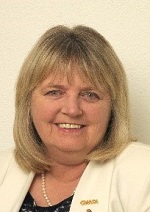BY CAROL GARNER, RN, CCMSA
South Africa is a country on the tip of the African continent with a population of 60 million and a land mass the size of Texas.
The healthcare structure is a combination of state-based care where every resident has access to basic healthcare; this involves long queues and waiting times, limited drugs and resources for 85% of the population. The remaining 15% is funded through private medical insurance or privately funded with access to first-world medical care equivalent to the best the world has to offer.
To add complexity to the situation, the country is faced with power challenges, the national grid is unable to supply power for 24 hours and has embarked on a serious of planned power outages across the country known as loadshedding. This affects all households, industry and hospitals; there is no escaping the rolling blackouts which last from 2 to 4 hours multiple times per day. Therefore, no matter how much funding is or is not available, the challenge of loadshedding is real.
With the impact of loadshedding, we plan our lives around cooking, travel, eating and various normal activities, but have we ever considered the patients on electrical devices such as oxygen concentrators or in the middle of surgery or who require a CT scan?
Loadshedding has the following effects:
- Interruption of medical procedures such as surgeries, dialysis and medical imaging tests.
- Disruption of medical equipment: Power outages can damage or disrupt the functioning of advanced medical equipment, such as life support machines and incubators.
- Medication storage: Power outages may cause medications that require refrigeration to spoil, affecting patients who rely on these medications to manage their health.
- Patient comfort and safety: Lack of electricity can disrupt the environmental control systems in medical facilities, making it difficult to maintain a comfortable and safe environment for patients.
- Communication and information: Loadshedding may disrupt communication within medical facilities, affecting the ability of medical staff to coordinate patient care and access essential information.
- Limited emergency services: Power outages can limit the availability of emergency services, such as ambulances and hospital admissions, due to the strain on backup power systems.
The need for additional backup power is a reality. The cost of powering a hospital to have uninterrupted supply can be millions per month. This has to be paid from the hospital operational budget and not billable to the patient or insurer. Households are forced to purchase generators, inverters or solar at a cost that is not normally part of the normal monthly budget.
An example is the oxygen concentrators that do not have battery backup and patients are forced to use oxygen cylinders during loadshedding; however, these cylinders do not last the full outage over two days and need to be refilled. What do patients do who live hundreds of kilometers away from the nearest depot?
Will their last breath be indeed their last?
Backup power supply is expensive and out of the financial means of our average elderly patient. They cannot have a generator running on at 2 a.m. when the power goes down because the neighbors will complain about the noise, and they cannot have it inside the home because of the fumes.
An Inverter the size required to power a concentrator for more than four hours will cost in the region of R20,000.
Solar power costs in the region of R250,000.
As case managers, we have the responsibility to keep the patients breathing, and this takes creativity and some serious negotiating power.
We know that the cost of an admission for respiratory distress is expensive and far outweighs the cost of the backup systems, but the medical insurers rules and benefit design regarding funding on non-healthcare equipment normally prohibit the financial support of these solutions.
In order to be proactive and to establish the need, we embarked on a project of identifying the patients who were at risk of readmission due to power challenges, this included patients on oxygen concentrators, negative pressure wound care, feeding pumps and Cpap.
We needed to know the volume we were dealing with in order to plan resources efficiently as each affected patient needed to be contacted in order to do a full needs assessment. Actuarial assistance was required with extracts from IT staff at schemes or at the suppliers. Due to multiple platforms and different data sources, this proved more of a challenge than was expected.
As case managers, our responsibility is to prepare a financial proposal to the schemes to indicate the cost of assisting with backup supply vs. the cost of admission. Some funders are open to providing an additional benefits for the inverter or generator as they see the benefit of avoiding unnecessary admissions.
It is our responsibility to empower our patients to make good responsible decisions, we need to provide them with all the information required and ensure they understand. It’s easier for new patients about to be discharged as the conversation can be had beforehand.
We live in times of crisis with regard to power supply, and we cannot sit back and wait for the inevitable.
To date, approximately 50 patients have died in the past three months due to lack of oxygen; some of these patients were always going to die, but they should never have died due to lack of breath.
Don’t keep yourself or your patients in the dark.
Be switched on!
 CAROL GARNER, RN, CCMSA, is Managing Director- Global Case Management Solutions (GCMS) and Executive Chairperson, Case Manager Association of SA.
CAROL GARNER, RN, CCMSA, is Managing Director- Global Case Management Solutions (GCMS) and Executive Chairperson, Case Manager Association of SA.
Carol’s extensive healthcare career began in 1975 where she began her nursing career at Greys Hospital in Pietermaritzburg.
During 1986, Carol joined CAMAF (Chartered Accountants Medical Aid Fund), where she embarked on her journey in the medical schemes industry spanning the past 39 years.
Carol is involved in both local and international healthcare markets with a broad client base across all sectors of the industry with a specific focus on case management and risk control. With her experience in the funding industry, she has a vast knowledge of the South African healthcare systems and how to navigate the challenges.
In April 2015, Carol left the corporate world and opened her own independent case management company focusing on onsite case management, transition of care and training of coding and prescribed minimum benefits, ensuring the most appropriate outcome for patients, funders and providers.
Carol is passionate about case management in SA and as the current executive chairperson of the Case Manager Association, is involved in the development and training of case managers with strong links to the USA, Australia UK. She is currently involved in the International Special Interest group assisting developing counties grow their case management industry.
Carol achieved her accreditation of Certified Clinical Case Manager South Africa in 2012 and was the first international recipient of the Case Manager of the Year Award presented in 2018.
Currently Carol has a team of case managers who, on behalf of funders, manages the patient journey in hospitals, ensuring transition of care and discharge planning happen seamlessly. In addition to this, the team assists providers code correctly to ensure patients claims are correctly paid.
Carol has a strong personal faith and holds true to family values; she has been happily married for 49 years and has four married children and eight grandchildren who keep her on her toes.
She takes a keen interest in all forms of sport and is a Tottenham Hotspurs and Western Province fan. She is working hard on improving her golf handicap, which is proving more of a challenge than she ever thought possible.
Carol firmly believes that more can be achieved by building bridges and relationships and working together as a team and surrounds herself with like-minded people.
She lives by the slogan “Just do it.”
Image credit: HYOTOGRAPHICS/SHUTTERSTOCK.COM




